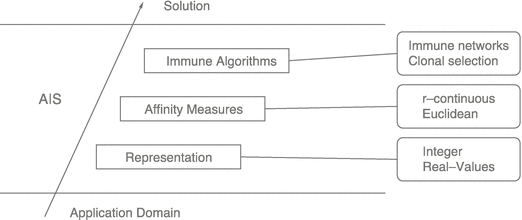Artificial Immune System (AIS) Algorithm
Jump to navigation
Jump to search
An Artificial Immune System (AIS) Algorithm is a Rule-base Machine Learning Algorithm that is based on a Immune System.
- Example(s):
- Counter-Example(s):
- See: Immune Network, Neural Network, Machine Learning System.
References
2018a
- (Wikipedia, 2018) ⇒ https://en.wikipedia.org/wiki/Artificial_immune_system Retrieved:2018-6-3.
- In artificial intelligence, artificial immune systems (AIS) are a class of computationally intelligent, rule-based machine learning systems inspired by the principles and processes of the vertebrate immune system. The algorithms are typically modeled after the immune system's characteristics of learning and memory for use in problem-solving.
2018b
- (Wikipedia, 2018) ⇒ https://en.wikipedia.org/wiki/Artificial_immune_system#Techniques Retrieved:2018-6-3.
- The common techniques are inspired by specific immunological theories that explain the function and behavior of the mammalian adaptive immune system.
- Clonal Selection Algorithm: A class of algorithms inspired by the clonal selection theory of acquired immunity that explains how B and T lymphocytes improve their response to antigens over time called affinity maturation. These algorithms focus on the Darwinian attributes of the theory where selection is inspired by the affinity of antigen-antibody interactions, reproduction is inspired by cell division, and variation is inspired by somatic hypermutation. Clonal selection algorithms are most commonly applied to optimization and pattern recognition domains, some of which resemble parallel hill climbing and the genetic algorithm without the recombination operator.
- Negative Selection Algorithm: Inspired by the positive and negative selection processes that occur during the maturation of T cells in the thymus called T cell tolerance. Negative selection refers to the identification and deletion (apoptosis) of self-reacting cells, that is T cells that may select for and attack self tissues. This class of algorithms are typically used for classification and pattern recognition problem domains where the problem space is modeled in the complement of available knowledge. For example, in the case of an anomaly detection domain the algorithm prepares a set of exemplar pattern detectors trained on normal (non-anomalous) patterns that model and detect unseen or anomalous patterns.
- Immune Network Algorithms: Algorithms inspired by the idiotypic network theory proposed by Niels Kaj Jerne that describes the regulation of the immune system by anti-idiotypic antibodies (antibodies that select for other antibodies). This class of algorithms focus on the network graph structures involved where antibodies (or antibody producing cells) represent the nodes and the training algorithm involves growing or pruning edges between the nodes based on affinity (similarity in the problems representation space). Immune network algorithms have been used in clustering, data visualization, control, and optimization domains, and share properties with artificial neural networks.
- Dendritic Cell Algorithms: The Dendritic Cell Algorithm (DCA) is an example of an immune inspired algorithm developed using a multi-scale approach. This algorithm is based on an abstract model of dendritic cells (DCs). The DCA is abstracted and implemented through a process of examining and modeling various aspects of DC function, from the molecular networks present within the cell to the behaviour exhibited by a population of cells as a whole. Within the DCA information is granulated at different layers, achieved through multi-scale processing.
- The common techniques are inspired by specific immunological theories that explain the function and behavior of the mammalian adaptive immune system.
2017
- (Timmis, 2017) ⇒ Jon Timmis.(2017). "Artificial Immune Systems". In: Sammut C., Webb G.I. (eds) Encyclopedia of Machine Learning and Data Mining. Springer, Boston, MA.
- Artificial immune systems (AIS) have emerged as a computational intelligence approach that shows great promise. Inspired by the complexity of the immune system, computer scientists and engineers have created systems that in some way mimic or capture certain computationally appealing properties of the immune system, with the aim of building more robust and adaptable solutions. AIS have been defined by de Castro and Timmis (2002) as:
- adaptive systems, inspired by theoretical immunology and observed immune functions, principle and models, which are applied to problem solving
- Artificial immune systems (AIS) have emerged as a computational intelligence approach that shows great promise. Inspired by the complexity of the immune system, computer scientists and engineers have created systems that in some way mimic or capture certain computationally appealing properties of the immune system, with the aim of building more robust and adaptable solutions. AIS have been defined by de Castro and Timmis (2002) as:
- AIS are not limited to machine learning systems, there are a wide variety of other areas in which AIS are developed such as optimization, scheduling, fault tolerance, and robotics (Hart and Timmis 2008). Within the context of machine learning, both supervised and unsupervised approaches have been developed. Immune-inspired learning approaches typically develop a memory set of detectors that are capable of classifying unseen data items (in the case of supervised learning) or a memory set of detectors that represent clusters within the data (in the case of unsupervised learning). Both static and dynamic learning systems have been developed (...)
